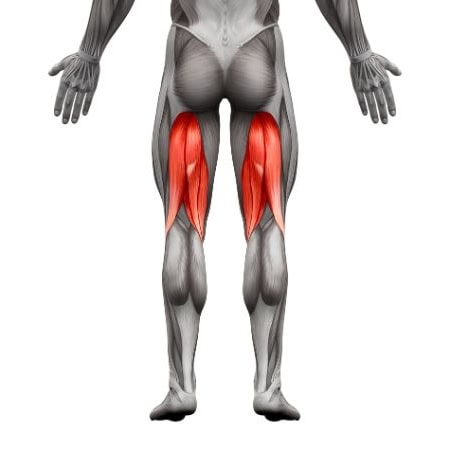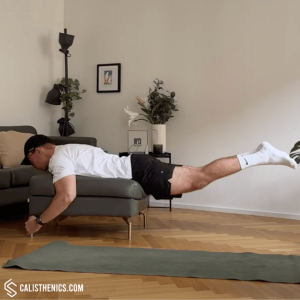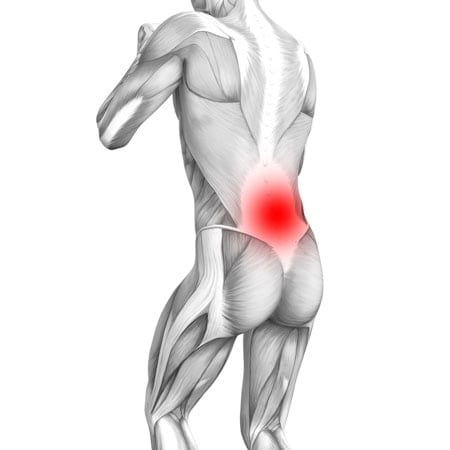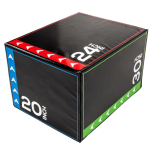Reverse Hyperextensions
How to do Reverse Hyperextensions?
Reverse hyperextensions (or reverse back extensions) are an effective bodyweight exercise that targets the lower back, glutes, and hamstrings. In this movement, the athlete lies face down on an elevated surface—such as a bench, plyo box, or any sturdy furniture—with their legs hanging off the edge. The athlete then lifts their legs upward, engaging the posterior chain. This exercise strengthens the lower back and improves hip extension, making it beneficial for enhancing spinal stability, posture, and lower-body strength. It’s an excellent alternative to more equipment-intensive back exercises and is a great way to counteract the effects of prolonged sitting.
Steps to Perform a Proper Reverse Hyperextension:
1. Set Up on an Elevated Surface:
• Lie face down on a bench, plyo box, or sturdy elevated surface with your hips at the edge. Your torso should be fully supported by the surface, while your legs dangle freely toward the floor.
• Grip the edges of the bench or surface with your hands for stability. Your head should remain in a neutral position, looking down to avoid straining your neck.
2. Engage Your Core and Posterior Chain:
• Before initiating the movement, engage your core by pulling your belly button toward your spine. Activate your glutes and hamstrings to prepare for the leg lift.
3. Lift Your Legs:
• Exhale as you lift both legs simultaneously, raising them to the height of your body or slightly higher. The lift should come from your glutes, hamstrings, and lower back.
• Keep your legs straight throughout the movement, and avoid bending at the knees. Your upper body should remain stable, with only your legs moving.
4. Squeeze at the Top:
• At the top of the movement, squeeze your glutes and hold for a brief moment to maximize muscle engagement. Your legs should be in line with your body or slightly higher, but avoid overextending them.
5. Lower Your Legs Back Down:
• Inhale as you slowly lower your legs back toward the floor in a controlled manner. Keep your glutes and lower back engaged to maintain tension in the muscles.
• Avoid letting your legs touch the floor between repetitions to keep constant engagement of the posterior chain.
6. Repeat:
• Perform the desired number of repetitions, maintaining a smooth, controlled pace and proper form throughout the exercise.
Benefits of Reverse Hyperextensions
• Strengthens the Lower Back: Reverse hyperextensions target the erector spinae muscles, which are crucial for maintaining spinal stability and reducing the risk of lower back pain.
• Enhances Glute and Hamstring Activation: This exercise heavily engages the glutes and hamstrings, making it effective for building lower-body strength and improving hip extension.
• Improves Hip Mobility: By focusing on hip extension, reverse hyperextensions help improve hip mobility, which is essential for functional movements like squatting, running, and jumping.
• Low Impact: This exercise is gentle on the joints, making it suitable for individuals recovering from injury or those looking for a low-impact way to strengthen their posterior chain.
• Improves Posture: Strengthening the lower back and glutes helps counteract the effects of prolonged sitting and can improve posture by supporting better spinal alignment.
• No Equipment Needed: Reverse hyperextensions can be performed on any sturdy elevated surface, making them accessible for home workouts or when gym equipment is limited.
Common Mistakes to Avoid
• Lifting the Legs Too High: Avoid lifting your legs too high, which can cause hyperextension of the lower back and lead to strain or injury. Keep your legs in line with your body or slightly higher.
• Using Momentum: Focus on slow, controlled movements rather than swinging your legs. Using momentum reduces muscle engagement and increases the risk of injury.
• Letting the Core Relax: Keep your core engaged throughout the movement to prevent your lower back from arching excessively.
• Not Controlling the Descent: Avoid letting your legs drop too quickly during the lowering phase. Controlled descent is key to maximizing muscle engagement and avoiding injury.
Tips for the proper execution of Reverse Hyperextensions
Engage the Glutes and Lower Back: Focus on using your glutes and lower back muscles to lift your legs, rather than relying on momentum or swinging.
Maintain Core Stability: Keep your core tight throughout the movement to stabilize your spine and prevent excessive arching of your lower back.
Controlled Movements: Perform the exercise slowly, especially during the lowering phase, to maximize muscle engagement and avoid injury.
Leg Height: Avoid lifting your legs too high, as overextending can strain your lower back. The goal is to raise your legs to the level of your body or slightly higher.
Breathing: Exhale as you lift your legs, and inhale as you lower them. Proper breathing helps maintain rhythm and control during the movement.
Muscles worked when doing Reverse Hyperextensions
Primary Muscles:
•Glutes: The gluteus maximus and medius are heavily engaged to lift and extend the legs during the movement.
•Lower Back: The erector spinae muscles along the spine help lift and stabilize the legs while maintaining spinal alignment.
Secondary Muscles:
•Hamstrings: Assist in extending the legs and work alongside the glutes to lift the lower body.
•Core: The abdominals and obliques stabilize the torso, preventing the lower back from overextending.
•Hip Flexors: Engaged during the lowering phase to control the descent and maintain leg stability.
Primary Muscle(s):
Secondary Muscle(s):

Hamstring
Adjust the difficulty of Reverse Hyperextensions
How to make Reverse Hyperextensions harder?
How to make Reverse Hyperextensions easier?
How to make Reverse Hyperextensions harder?
To make Reverse Hyperextensions harder:
-
Add Resistance: Place ankle weights or a resistance band around your legs to increase the challenge and further engage your glutes and hamstrings.
-
Slow Down the Tempo: Slow down the lifting and lowering phases to increase time under tension, which engages the muscles more deeply.
-
Hold at the Top: Add a 2-3 second pause at the top of each repetition to increase muscle engagement and build endurance in the lower back and glutes.
-
Increase Repetitions or Sets: Perform more repetitions or sets to challenge your endurance and strength further.
How to make Reverse Hyperextensions easier?
To make Reverse Hyperextensions easier:
-
Perform a Partial Range of Motion: Lift your legs only partway up instead of fully extending them. This reduces the intensity while still engaging the muscles.
-
Use a Lower Surface: Perform the exercise on a lower surface (such as a low bench) to decrease the difficulty and reduce the range of motion.
-
Perform Single-Leg Variations: Lift one leg at a time, which reduces the load on the lower back and allows you to focus on building strength gradually.




